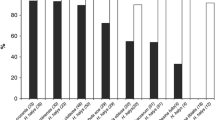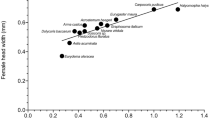Abstract
Trissolcus japonicus is an egg parasitoid of Halyomorpha halys, brown marmorated stink bug, a severe agricultural pest in the USA. T. japonicus is being evaluated in quarantine as a classical biological control agent to manage H. halys populations in the USA. To determine T. japonicus’ potential for successful management of the pest, we performed a series of no-choice and paired-host-range tests, evaluating parasitism and host recognition in ten nontarget insects. In laboratory no-choice tests, T. japonicus successfully parasitized egg masses of seven Pentatomidae native to Oregon in addition to H. halys. Mean parasitism proportions of egg masses were greater than 40% in two species, B. dimidiata and H. abbreviatus, and were statistically similar to parasitism of H. halys. However, paired-host tests identified higher proportions of parasitized H. halys egg masses compared to four other pentatomids. T. japonicus was equally attracted to volatiles produced by H. halys and other pentatomids but demonstrated significantly longer arrestment response time on surfaces with H. halys contact kairomones. Although host acceptance patterns were similar between stink bug species, our results suggest a greater potential for parasitoid development in H. halys eggs compared to the native pentatomids. During host-range testing, we detected field populations of T. japonicus at 11 sites in Portland, OR, indicating an unintentional introduction and establishment. Further work is needed to characterize its nontarget activity and dispersal patterns in areas where H. halys causes economic damage in Oregon.


Similar content being viewed by others
References
Aldrich J, Khrimian A, Chen X, Camp M (2009) Semiochemically based monitoring of the invasion of the brown marmorated stink bug and unexpected attraction of the native green stink bug (Heteroptera: Pentatomidae) in Maryland. Fla Entomol 92:483–491
Babendreier D, Bigler F, Kuhlmann U (2005) Methods used to assess non-target effects of invertebrate biological control agents of arthropod pests. Biocontrol 50:821–870. doi:10.1007/s10526-005-3633-3
Battaglia D, Pennacchio F, Romano A, Tranfaglia A (1995) The role of physical cues in the regulation of host recognition and acceptance behavior of Aphidius ervi Haliday (Hymenoptera: Braconidae). J Insect Behav 8:739–750. doi:10.1007/BF02009503
Bellows TS, Fisher TW (eds) (1999) Handbook of biological control. Academic Press, San Diego
Bin F, Vinson SB, Strand MR et al (1993) Source of an egg kairomone for Trissolcus basalis, a parasitoid of Nezara viridula. Physiol Entomol 18:7–15. doi:10.1111/j.1365-3032.1993.tb00443.x
Blaauw BR, Polk D, Nielsen AL (2015) IPM-CPR for peaches: incorporating behaviorally-based methods to manage Halyomorpha halys and key pests in peach. Pest Manag Sci 71:1513–1522
Caltagirone LE (1981) Landmark examples in classical biological control. Ann Rev Entomol 26:213–232. doi:10.1146/annurev.en.26.010181.001241
Colazza S, Salerno G, Wajnberg E (1999) Volatile and contact chemicals released by Nezara viridula (Heteroptera: Pentatomidae) have a kairomonal effect on the egg parasitoid Trissolcus basalis (Hymenoptera: Scelionidae). Biol Control 16:310–317. doi:10.1006/bcon.1999.0763
Conti E, Salerno G, Bin F et al (2003) Chemical cues from Murgantia histrionica eliciting host location and recognition in the egg parasitoid Trissolcus brochymenae. J Chem Ecol 29:115–130. doi:10.1023/A:1021980614512
Cornelius ML, Dieckhoff C, Hoelmer KA et al (2016) Biological control of sentinel egg masses of the exotic invasive stink bug Halyomorpha halys (Stal) in Mid-Atlantic USA ornamental landscapes. Biol Control 103:11–20
Dicke M, van Loon JJA (2000) Multitrophic effects of herbivore-induced plant volatiles in an evolutionary context. Entomol Exp Appl 97:237–249. doi:10.1046/j.1570-7458.2000.00736.x
Dobson RC, Rogers M, Moore JLC, Bessin RT (2016) Exclusion of the brown marmorated stink bug from organically grown peppers using barrier screens. HortTech 26:191–198
Ehler LE (1991) Planned introductions in biological control. In: Ginzburg LR (ed) Assessing ecological risks of biotechnology. Butterworth-Heinemann, Boston, pp 21–39
Hedstrom C (2016) Stink bugs of Oregon. http://www.oregon.gov/ODA/shared/Documents/Publications/IPPM/StinkBugGuide.pdf. Accessed 15 Jan 2017
Herlihy MV, Talamas EJ, Weber DC (2016) Attack and success of native and exotic parasitoids on eggs of Halyomorpha halys in three Maryland habitats. PLoS ONE 11:e0150275. doi:10.1371/journal.pone.0150275
Hilker M, Fatouros NE (2015) Plant response to insect eggs. Ann Rev Entomol 60:493–515
Hough-Goldstein J, McPherson D (1996) Comparison of Perillus bioculatus and Podisus maculiventris (Hemiptera:Pentatomidae) as potential control agents of the Colorado potato beetle (Coleoptera: Chrysomelidae). J Econ Entomol 89:1116–1123
Howarth F (1991) Environmental impacts of classical biological control. Ann Rev Entomol 36:485–509. doi:10.1146/annurev.en.36.010191.002413
Kivan M, Kilic N (2004) Influence of host species and age on host preference of Trissolcus semistriatus. Biol Control 49:553–562. doi:10.1023/B:BICO.0000036436.06260.19
Koçak E, Kilinçer N (2003) Taxonomic studies on Trissolcus sp. (Hymenoptera: Scelionidae), egg parasitoids of the sunn pest (Hemiptera: Scutelleridae: Eurygaster sp.), in Turkey. Turk J Zool 27:301–317
Leskey TC, Hamilton GC, Nielsen AL et al (2012a) Pest status of the brown marmorated stink bug, Halyomorpha halys in the USA. Outlooks Pest Manag 23:218–226. doi:10.1564/23oct07
Leskey TC, Wright SE, Short BD, Khrimian A (2012b) Development of behaviorally-based monitoring tools for the brown marmorated stink bug (Heteroptera: Pentatomidae) in commercial tree fruit orchards. J Entomol Sci 47:76–85. doi:10.18474/0749-8004-47.1.76
Louda SM, Pemberton RW, Johnson MT, Follett P (2003) Nontarget effects—the Achilles’ heel of biological control? Retrospective analyses to reduce risk associated with biocontrol introductions. Ann Rev Entomol 48:365–396
McDonald JH (2014) Handbook of biological statistics, 2nd edn. Sparky house publishing, Baltimore
McEvoy PB (1996) Host specificity and biological pest control. Bioscience 46:401–405. doi:10.2307/1312873
Michaud JP, Mackauer M (1994) The use of visual cues in host evaluation by aphidiid wasps: I. Comparison between three Aphidius parasitoids of the pea aphid. Entomol Exp Appl 70:273–283
Milnes JM, Wiman NG, Talamas EJ et al (2016) Discovery of an exotic egg parasitoid of the brown marmorated stink bug, Halyomorpha halys (stål) in the Pacific Northwest. Proc Entomol Soc Wash 118:466–470. doi:10.4289/0013-8797.118.3.466
Montemayor CO, Cave RD (2011) Development time and predation rate of Podisus maculiventris (Hemiptera: Pentatomidae) feeding on Microtheca ochroloma (Coleoptera: Chrysomelidae). Environ Entomol 40:948–954. doi:10.1603/EN10275
Morrison WR, Mathews CR, Leskey TC (2016) Frequency, efficiency, and physical characteristics of predation by generalist predators of brown marmorated stink bug (Hemiptera: Pentatomidae) eggs. Biol Control 97:120–130
NE IPM (2017) State-by-State - StopBMSB.org. In: State-by-State—StopBMSB.org. http://www.stopbmsb.org/where-is-bmsb/state-by-state/. Accessed 21 Jan 2014
Nielsen AL, Hamilton GC (2009) Seasonal occurrence and impact of Halyomorpha halys (Hemiptera: Pentatomidae) in tree fruit. J Econ Entomol 102:1133–1140. doi:10.1603/029.102.0335
Nielsen AL, Hamilton GC, Matadha D (2008) Developmental rate estimation and life table analysis for Halyomorpha halys (Hemiptera: Pentatomidae). Environ Entomol 37:348–355
Nielsen AL, Dively G, Pote JM et al (2016) Identifying a potential trap crop for a novel insect pest, Halyomorpha halys (Hemiptera: Pentatomidae), in organic farms. Environ Entomol 45:472–478. doi:10.1093/ee/nvw006
Peri E, Sole MA, Wajnberg E, Colazza S (2006) Effect of host kairomones and oviposition experience on the arrestment behavior of an egg parasitoid. J Exp Biol 209:3629–3635
R Core Team (2016) R: a language and environment for statistical computing. Vienna, Austria
Roubos CR, Rodriguez-Saona C, Holdcraft R et al (2014) Relative toxicity and residual activity of insecticides used in blueberry pest management: mortality of natural enemies. J Econ Entomol 107:277–285
Salerno G, Conti E, Peri E et al (2006) Kairomone involvement in the host specificity of the egg parasitoid Trissolcus basalis (Hymenoptera: Scelionidae). Eur J Entomol 103:311–318
Sales FM, McLaughlin JR, Sailer RI et al (1980) Quantitative analysis of the behavior patterns of the female, Trissolcus basalis (Wollaston) when stimulated by the kairomonal extract of the host, Nezara viridula (L.). Fitossanidade 4:43–50
Talamas E, Buffington M, Hoelmer K (2013) New synonomy of Trissolcus halyomorphae Yang. J Hymenop Res 33:113–117. doi:10.3897/jhr.33.5627
Talamas EJ, Herlihy MV, Dieckhoff C et al (2015) Trissolcus japonicus (ashmead) (Hymenoptera, Scelionidae) emerges in North America. J Hymenopt Res 43:119–128. doi:10.3897/JHR.43.4661
Van Driesche R, Heard T, McClay A, Reardon R (2000) Host-specificity testing of exotic arthropod biological control agents: the biological basis for improvement in safety. In: International symposium on biological control of weeds FHTET-99-1, UDSA, Morgantown
Vinson SB (1984) Parasitoid—host relationship. In: Chemical ecology insects. Springer, pp 205–233
Wiman N, Rondon S, Walton V, Shearer P (2014) Distribution of brown marmorated stink bug in Oregon and risk for specialty crops. In: Research reports 72nd annual Pacific NW insect management conference. p 42
Yang Z-Q, Yao Y-X, Qiu L-F, Li Z-X (2009) A new species of Trissolcus (Hymenoptera: Scelionidae) parasitizing eggs of Halyomorpha halys (Heteroptera: Pentatomidae) in China with comments on its biology. Ann Entomol Soc Am 102:39–47
Acknowledgements
We acknowledge Christine Dieckhoff and Kim Hoelmer, USDA-ARS, Newark DE, for providing standardized methods for choice and paired-host assays across multiple laboratories performing similar evaluations of T. japonicus in the USA, and for providing the initial Trissolcus japonicus specimens for our experimentation. Elijah Talamas provided parasitoid species determinations. Thank you to Phillip Coombs and Joyce Takeyasu, (Oregon Department of Agriculture, Salem, OR) for help in acquiring pentatomids in Oregon. Thanks to Kody Transue, Chase Unger and Kylie Mendonca (Oregon State University, Corvallis, OR) and Colin Park and Jodie Lombardi (USDA APHIS-PPQ, Portland, OR) for placing and monitoring sentinel egg masses. Thanks to Tracy Johnson (USFS, Volcano, HI) for providing Coleotichus egg masses. This research was funded in part by USDA Farm Bill 15-8130-0022-CA, and USDA-NIFA-SCRI-2011-51181-3-037.
Author information
Authors and Affiliations
Corresponding author
Additional information
Communicated by T. Haye.
Special Issue: The brown marmorated stink bug Halyomorpha halys an emerging pest of global concern.
Rights and permissions
About this article
Cite this article
Hedstrom, C., Lowenstein, D., Andrews, H. et al. Pentatomid host suitability and the discovery of introduced populations of Trissolcus japonicus in Oregon. J Pest Sci 90, 1169–1179 (2017). https://doi.org/10.1007/s10340-017-0892-6
Received:
Revised:
Accepted:
Published:
Issue Date:
DOI: https://doi.org/10.1007/s10340-017-0892-6




